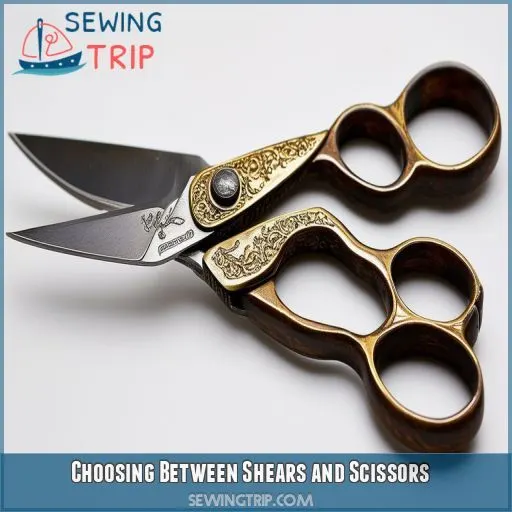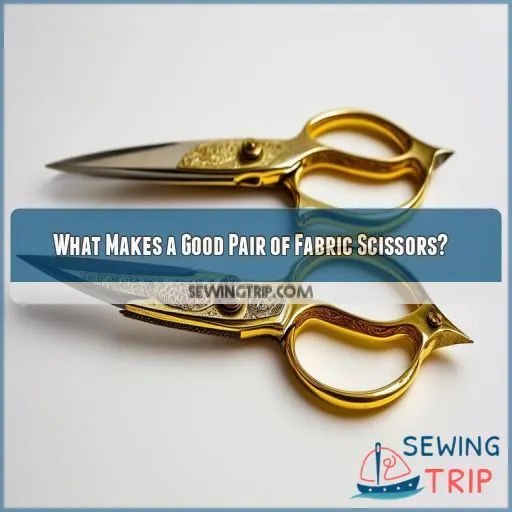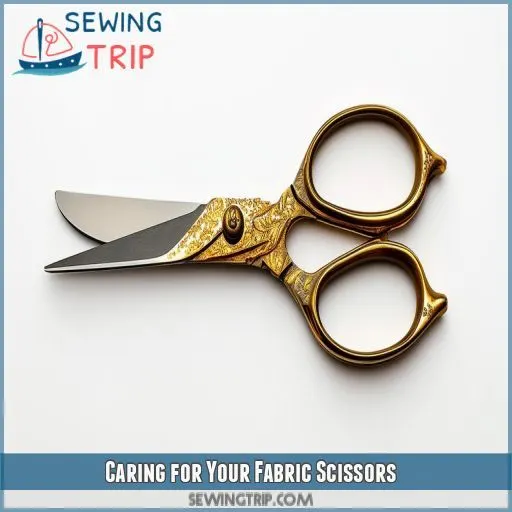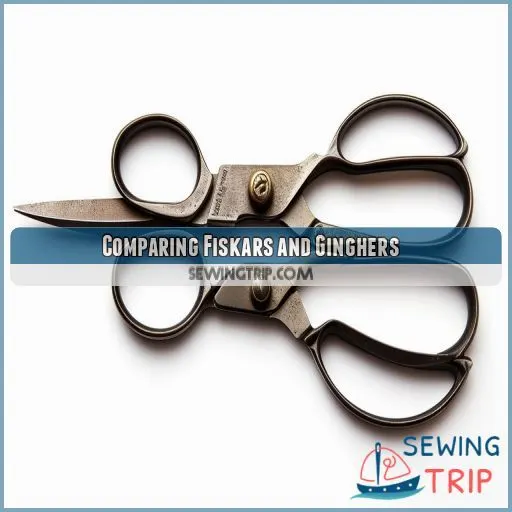This site is supported by our readers. We may earn a commission, at no cost to you, if you purchase through links.
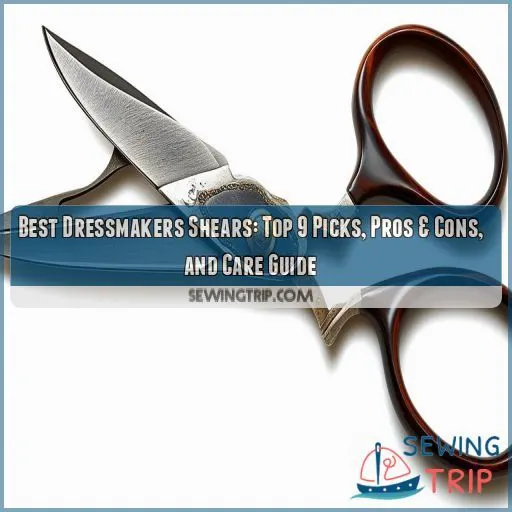 Searching for the best dressmakers shears can be overwhelming. You’ll find a wide array of options, each promising precision and comfort.
Searching for the best dressmakers shears can be overwhelming. You’ll find a wide array of options, each promising precision and comfort.
This guide will help you navigate the top 9 picks, examining their pros and cons. You’ll learn what makes a quality pair of shears and how to care for them properly.
We’ll also compare popular brands like Fiskars and Gingher.
Table Of Contents
- Key Takeaways
- Top 9 Best Dressmakers Shears
- 1. Guggenhein Professional Tailor Shears
- 2. Purple Perfect Scissors
- 3. Tula Pink Curved EZ Snip
- 4. Havels Snip Eze Embroidery Snips
- 5. Handi Quilter Batting Scissors
- 6. Kai Ergonomic Pinkers Sewing Scissors
- 7. Gingher Curved Embroidery Scissors
- 8. Gingher Dressmaker Fabric Scissors
- 9. Kai Pink Handle Sewing Scissors
- Choosing Between Shears and Scissors
- What Makes a Good Pair of Fabric Scissors?
- Caring for Your Fabric Scissors
- Comparing Fiskars and Ginghers
- Frequently Asked Questions (FAQs)
- Conclusion
Key Takeaways
- Choosing the right shears is like finding your sewing soulmate – it’s all about the perfect fit for your hand and cutting style. Whether you’re Team Fiskars or a Gingher guru, invest in quality and your future projects will thank you.
- Don’t be caught with your scissors down! Regular maintenance is key to keeping your blades sharp and rust-free. A little TLC goes a long way – think of it as a spa day for your shears.
- One size doesn’t fit all in the world of cutting tools. From curved embroidery scissors to heavy-duty pinking shears, there’s a specialized tool for every job. It’s like having the right golf club for each swing – your cuts will be smoother than a well-pressed seam.
- Remember, your fabric scissors are like fine china – save them for special occasions (i.e., fabric only!). Using them on paper is a cardinal sin in the sewing world, akin to wearing white to a wedding. Keep a separate pair for your paper-cutting needs and your shears will live long and prosper.
Top 9 Best Dressmakers Shears
Regarding the best dressmakers shears, the top 9 selections include esteemed options such as the Guggenhein Professional Tailor Shears and the Gingher Dressmaker Fabric Scissors. These specialized scissors each provide unique attributes and advantages that cater to the specific demands of sewing and tailoring enthusiasts.
1. Guggenhein Professional Tailor Shears
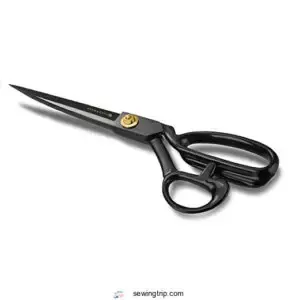
The Guggenhein Professional Tailor Shears are a solid choice for dressmakers seeking sharp and precise cutting tools.
Made from alloy steel, these 8-inch shears pack a punch with their weight and ability to cut through various fabrics like silk, cotton, and heavier materials.
While they may not be ideal for those with arthritis due to their weight, they offer an affordable price point and excellent customer service.
Be sure to wipe off the packing grease before using, as it can transfer to your fabric.
With their money-back guarantee and complimentary replacement if not satisfied, these shears are a safe bet for any sewing enthusiast.
Best For: Dressmakers seeking sharp and precise cutting tools.
- Affordable price point
- Cuts through various fabrics
- Excellent customer service
- Weighty, not recommended for those with arthritis
- Packing grease may get on fabric
- Sharp, precise points may be intimidating for some users
2. Purple Perfect Scissors
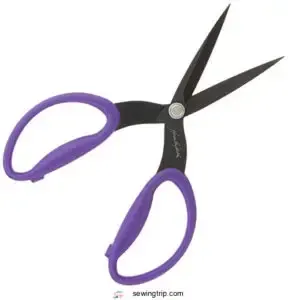
The Purple Perfect Scissors by Karen Kay Buckley are a highly recommended and affordable option for dressmakers.
These scissors feature a micro-serrated blade that pulls fabric into the scissors, ensuring a clean cut.
The blades are sharp to the very tip, and the serrated edge helps prevent fabric fraying.
They are lightweight, comfortable to hold, and suitable for both right- and left-handed users.
However, those with small hands may find the scissors too large, as the thumb hole is the same size as the finger hole.
Best For: Dressmakers and quilters seeking a sharp, affordable pair of scissors.
- Micro-serrated blade pulls fabric into scissors for a clean cut
- Blades sharp to the very tip and serrated to prevent fraying
- Lightweight and comfortable to hold
- May be too large for small hands
- Thumb hole is the same size as the finger hole
- Imported
3. Tula Pink Curved EZ Snip

If you’re seeking a tool that allows you to get close to the material without accidentally cutting it, the Tula Pink Curved EZ Snip is a must-have.
With its curved design, you can trim threads while sewing, confidently avoiding any snags, jabs, or pokes.
The titanium-coated, micro-serrated blade holds your thread in place, ensuring clean cuts every time.
These snips, made in the USA, are lightweight, easy to use, and fit effortlessly under a presser foot.
While they may not have the same smoothness as Fiskars snips, their sharpness and ability to stay in place between the blades make them a favorite among sewers.
Best For: Sewers who need to get close to the material without accidentally cutting it.
- Curved design for precision trimming
- Titanium-coated, micro-serrated blade for clean cuts
- Lightweight and easy to use
- May have a slight burr or roughness at the blade tip
- Not as smooth as Fiskars snips
- May not be suitable for all sewing tasks
4. Havels Snip Eze Embroidery Snips
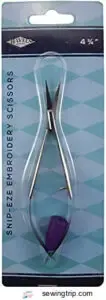
Havels Snip Eze Embroidery Snips are a must-have tool for any sewer.
Easy to use, with a simple squeeze action and curved tips, they are convenient, lightweight, and perfect for those with tired or arthritic hands.
The pointed tips and squeeze-to-use design make these snips ideal for hand and machine embroidery, and they are suitable for both right and left-handed users.
While some users find them worth the cost, especially for clipping fabric and cutting thread, others feel they could be improved.
The curved blades are very sharp. Take care not to drop them, as they can bend out of shape.
Best For: Sewers, embroiderers, and those with tired or arthritic hands.
- Easy squeeze action
- Pointed tips for precision cutting
- Suitable for both right and left-handed users
- Can bend out of shape if dropped
- Some users find them pricey
- Not as durable as other options
5. Handi Quilter Batting Scissors
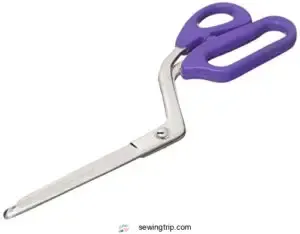
If you’re a quilter or a long armer, the Handi Quilter Batting Scissors are a must-have.
These scissors are designed specifically for cutting batting, with a rounded tip to prevent snagging and ergonomic handles for comfortable cutting.
The 5-inch straight-edge cutting blade stays sharp and easily cuts through batting.
You won’t experience any hanging up on the tips, and quilters highly recommend them.
Best For: Quilters and long armers
- Designed specifically for cutting batting
- Rounded tip to prevent snagging
- Ergonomic handles for ease in cutting
- Not specified
6. Kai Ergonomic Pinkers Sewing Scissors
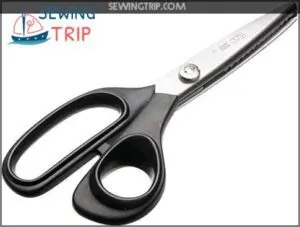
If you’re looking for a reliable pair of pinking shears, the Kai Ergonomic Pinkers Sewing Scissors (Model 5350) are a great option.
They feature offset thumb blades with rubber finger inserts for maximum comfort and control.
The fine stainless steel blades with Vanadium guarantee sharp, lasting edges.
With an overall length of 8" and a 3" cutting length, these scissors are perfect for thick fabrics.
Best For: Thick fabrics due to their sharp teeth and ergonomic design.
- Offset thumb blade with rubber finger inserts for maximum comfort
- Sharp teeth and fine stainless steel blades with Vanadium
- Ergonomically designed for lasting edges
- Not suitable for delicate fabrics due to sharp teeth
- May require sharpening after extended use
- Pricey compared to other pinking shears
7. Gingher Curved Embroidery Scissors
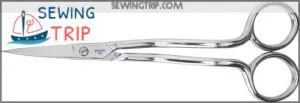
The Gingher Curved Embroidery Scissors are a dependable tool for your sewing kit.
With forged steel and precision-ground, knife-edge blades, these scissors offer durability and precise cuts.
The double-curved handle design allows you to easily reach over an embroidery hoop. Meanwhile, the narrow blades and sharp points enable close, detailed cuts.
The ergonomic double-loop handle ensures a comfortable grip, and the double-plated chrome-over-nickel finish adds to the scissors’ longevity.
This product includes a full lifetime warranty, giving you peace of mind.
Best For: Those seeking precision cuts in embroidery, needlework, and other crafts.
- Forged steel and precision-ground blades for durability and accuracy
- Double-curved handle for reaching over embroidery hoops
- Ergonomic double loop handle for comfortable grip
- Not suitable for heavy-duty cutting tasks
- May require sharpening over time
- Not dishwasher safe
8. Gingher Dressmaker Fabric Scissors
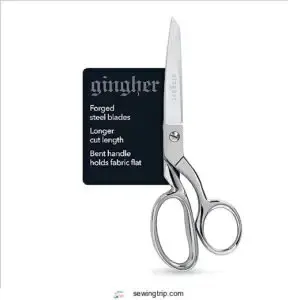
Gingher Dressmaker Fabric Scissors are a reliable choice for any sewing enthusiast. These shears feature precision-ground blades for accurate measurements and cutting. The hand-finished blades are double-plated with a chrome-over-nickel finish, ensuring durability and a long-lasting sharp edge. The bent handle design allows you to hold fabric flat while cutting, providing a comfortable experience. These shears also come with a protective nylon sheath for safe storage when not in use.
A great addition to your craft supplies, these shears are perfect for cutting patterns, trimming seams, or handling long swaths of fabric. With their premium, forged steel construction, you can trust these shears to deliver precise and comfortable cuts every time.
Best For: Sewing enthusiasts looking for precise, durable, and comfortable fabric scissors.
- Precision-ground blades for accurate measurements
- Durable, hand-finished blades with double-plated chrome-over-nickel finish
- Comfortable bent handle for holding fabric flat while cutting
- Weight not specified
- No information on blade thickness or bevel angle
- May not be suitable for heavy-duty cutting tasks
9. Kai Pink Handle Sewing Scissors
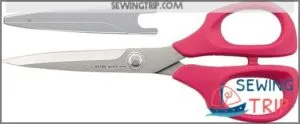
The Kai Pink Handle Sewing Scissors are a premium choice for any sewing enthusiast.
Made with NSSWR-2 steel, these scissors offer an excellent feel and smooth, sharp cutting action.
The 16.5 cm blades are rustproof and showcase Japanese craftsmanship, ensuring precision and durability.
These scissors are small enough for fine work, yet substantial and well-made. They also come with a protective cover for safe storage.
Best For: Experienced sewers seeking precision and durability.
- Sharp, smooth cutting action
- Rustproof NSSWR-2 steel construction
- Protective cover for safe storage
- Not suitable for heavy-duty cutting
- May be too small for some users
- Not dishwasher safe
Choosing Between Shears and Scissors
Choosing between shears and scissors depends on your cutting needs and the specific tasks at hand. Shears are ideal for cutting larger fabric pieces with precision, while scissors are better suited for detailed, smaller cuts and portability.
Differences in Design and Functionality
Regarding selecting shears or scissors for dressmaking, understanding the design and functionality differences is critical. Shears feature blades 6 inches or longer, with one finger hole smaller than the other, and one rounded blade to prevent snagging. They’re designed for cutting larger fabrics and can cut at an angle. In contrast, scissors have blades less than 6 inches in length and equally sized finger holes. Scissors are intended for smaller, more portable cutting tasks.
When choosing the right tool, consider factors such as size, comfort, and weight. Try on different options to find the perfect fit for your hand. All-metal shears, for example, tend to be heavier, while plastic-handled shears are lighter. Titanium shears offer a middle ground, providing durability without the weight of steel.
When to Use Shears
When selecting between shears and scissors for dressmaking, it is important to consider the task at hand.
Shears are designed for cutting larger fabrics and can handle multiple layers of thick materials, such as denim. The blades of shears are typically 6 inches or longer, making them ideal for cutting fabric pattern pieces and trimming seams.
Additionally, the rounded ends of shears prevent snagging, ensuring a clean cut. The finger holes are also designed for comfort and precise control, with one larger hole and one smaller hole, which is especially beneficial during extended cutting sessions.
When to Use Scissors
Now that you know when to use shears, let’s discuss when to use scissors. Scissors are ideal for smaller, more precise cutting tasks and are highly portable. They’re typically used for trimming seams and small pieces of fabric. When choosing scissors, consider different blade shapes, handle design, cutting precision, comfort, and maintenance.
What Makes a Good Pair of Fabric Scissors?
When choosing fabric scissors, focus on the type and quality of steel for durability and sharpness, ensuring they can handle various fabrics with ease. Consider the shape and fit of the handle for comfort, alongside the blade shape and tension for precise and accurate cuts.
Type and Quality of Steel
In selecting the optimal fabric scissors, the nature and quality of steel play a pivotal role:
- High-Carbon Stainless Steel: Blades crafted from high-carbon stainless steel offer exceptional longevity and retain their sharpness for an extended period. This alloy seamlessly blends carbon and chromium, guaranteeing your scissors remain sharp and resistant to corrosion.
- Corrosion Resistance: Corrosion-resistant scissors are essential to prevent rust and prolong their lifespan. Consider stainless steel or high-carbon stainless steel options.
- Precision Knife Edge: A precise knife edge facilitates clean, accurate cuts. Italian craftsmanship, like the Gingher brand, is renowned for its precision knife edges.
- Japanese Craftsmanship: Japanese brands, such as Kai, are known for their high-quality blades. Their scissors feature high-carbon stainless steel blades that cut through multiple layers of denim effortlessly.
- Sharp and Durable: Sharp scissors with a lasting edge are critical for precise cutting. Look for brands that prioritize blade quality and sharpness.
Shape and Fit of Handle
In relation to the shape and fit of the handle, you want to guarantee maximum comfort and control. Search for handles with an ergonomic design, providing a natural and comfortable grip. Cushioned or padded handles provide additional comfort, especially during prolonged use.
Handle size is also important. Try out different sizes to find your perfect fit—you don’t want handles that squeeze or rub against your skin. Left-handed? No problem! Many scissors offer left-handed options, so everyone can find their ideal pair.
Blade Shape and Tension
Blade shape and tension are critical factors in achieving clean, precise cuts with your dressmaker’s shears. Straight blades are ideal for cutting straight lines and intricate details, while curved blades excel at maneuvering curves and complex shapes. If you’re working with tough or slippery fabrics, serrated blades provide a secure grip, although they may not produce the cleanest cuts.
To guarantee accurate cutting, adjust the blade tension according to the fabric type. This feature allows you to customize the cutting action for different materials, ensuring smooth, effortless cuts every time. Remember to maintain your blades by sharpening them periodically and keeping them dry to prevent rust and corrosion.
Caring for Your Fabric Scissors
To keep your dressmaker’s shears in top condition, be sure to clean them regularly with a soft, dry cloth to remove any lint or residue. Additionally, have your shears professionally sharpened when they start to lose their edge, as this will help maintain their precision and longevity.
Preventing Dulling and Rust
To prevent dulling and rust on your fabric scissors, it’s imperative to maintain them properly. Here are key tips to keep your shears in optimal condition:
- Store them in a dry place to avoid moisture-induced rust
- Use an oily cloth after each use to protect the blades
- Apply a fabric protector to safeguard against corrosion
Regular Cleaning and Sharpening
To preserve your fabric scissors’ longevity, regular cleaning and sharpening are essential. After each use, wipe the blades with a soft cloth to remove lint and debris. For embroidery scissors and micro-serrated edges, use a gentle brush. Apply a drop of machine oil to prevent corrosion.
Sharpen your Mundial dressmaker shears and quilting scissors annually using a professional service or a whetstone, maintaining their precision for bag making and other tasks.
Adjusting Blade Tension
After cleaning and sharpening, don’t forget to verify your shears’ blade tension. Proper tension contributes to clean cuts and avoids fabric damage.
To adjust, locate the screw at the pivot point. Tighten for heavier fabrics, loosen for delicate ones. Test on scrap fabric to ascertain ideal tension settings.
Regular blade maintenance, including tension adjustment, keeps your shears functioning like new.
Comparing Fiskars and Ginghers
You’ll find that Fiskars and Ginghers are two top contenders in the dressmaker shears market, each offering unique features. Fiskars often provides ergonomic handles and razor-sharp blades, while Ginghers are known for their precision-ground knife edge and exceptional durability.
Features and Benefits of Fiskars
Now, let’s turn our attention to Fiskars, a brand that’s made a name for itself in the sewing world.
You’ll find Fiskars shears are built to last, with durability that’ll keep you cutting for years. They’ve nailed the comfort factor too, with ergonomic designs that’ll have you sewing all day without hand fatigue.
Plus, many Fiskars models are ambidextrous, so both lefties and righties can enjoy their precision cuts.
Features and Benefits of Ginghers
Ginghers are the gold standard in dressmaking shears, known for their precision and durability. You’ll appreciate their:
- Razor-sharp blades that glide through fabric like butter
- Ergonomic handles that feel like an extension of your hand
- Impressive longevity with proper care and maintenance
- Iconic "knife-edge" design for unmatched accuracy
While pricier than Fiskars, Ginghers’ superior quality and lifetime warranty make them a worthwhile investment for serious sewers who demand perfection in every cut.
Frequently Asked Questions (FAQs)
Which are the best dressmaking shears?
You’ll want high-quality dressmaking shears for precision cutting. Gingher 8" Dressmaker’s Shears and Kai 5210 8" Dressmaking Shears are top choices. They’re sharp, durable, and comfortable to use, making your sewing projects a breeze.
What shears are best for cutting out a garment?
For cutting out garments, you’ll want sturdy, sharp shears with long blades. Look for 8-9 inch dressmaker’s shears with one pointed and one rounded tip. They’ll glide through fabric smoothly, ensuring precise cuts for your projects.
What is the difference between Fiskars and Ginghers?
You’ll notice Fiskars are more affordable and lightweight, with ergonomic handles. Ginghers, on the other hand, are pricier but offer superior craftsmanship and durability. Fiskars are great for everyday use, while Ginghers are favored by professionals for precision cutting.
What is the difference between scissors and dressmaker shears?
You’ll notice scissors have equal-sized finger holes and shorter blades, while dressmaker shears boast one smaller hole and longer blades. Shears cut larger fabrics at angles, whereas scissors handle smaller tasks and offer portability.
Can dressmakers shears be used for cutting paper?
You shouldn’t use dressmaker shears for cutting paper. It’ll dull the blades, compromising their precision on fabric. Reserve them for their intended purpose – cutting cloth. For paper, grab a pair of standard scissors instead.
How often should professional seamstresses replace their shears?
Are your shears losing their edge? You should replace them every 1-2 years, depending on usage. Professional seamstresses often replace shears annually, but with proper care and sharpening, they can last longer. Regular maintenance is key to longevity.
Are titanium-coated blades worth the extra cost?
You’ll find titanium-coated blades worth the investment. They’re sharper, more durable, and resistant to corrosion. You’ll cut through fabrics effortlessly, and they’ll stay sharp longer. For pros who use shears daily, they’re a game-changer.
Can dressmakers shears be safely stored in magnetic holders?
You can safely store dressmakers shears in magnetic holders, but it’s not ideal. Magnetic fields might affect blade alignment over time. Instead, opt for a fabric sleeve or dedicated case to protect your shears’ precision and longevity.
Do electric fabric shears work well for dressmaking?
You’ll find electric fabric shears can work well for dressmaking, but they’re not without drawbacks. They’re efficient for thick fabrics and long cuts, but may lack precision for intricate work. Consider your specific needs before investing.
Conclusion
Ironically, finding the best dressmakers shears** can be as challenging as cutting a perfect circle freehand. But armed with this guide, you’re now equipped to make an informed decision.
You’ve explored top picks, learned what makes quality shears, and discovered proper care techniques.
Whether you choose Fiskars, Ginghers, or another brand, remember that the right shears can elevate your sewing projects.
Invest wisely, maintain them well, and you’ll have a trusty tool for years to come. Happy snipping!

